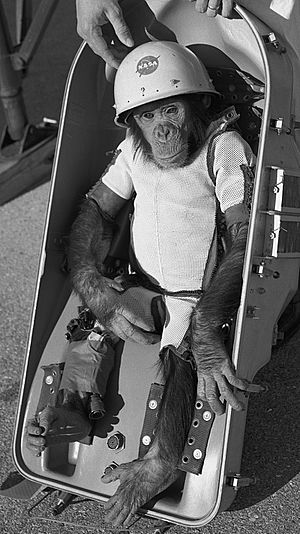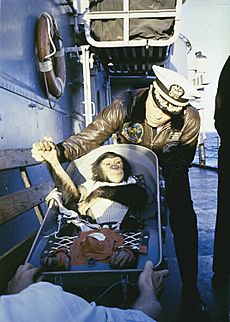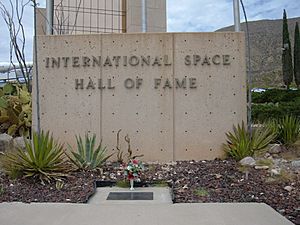Ham (chimpanzee) facts for kids

Ham in January 1961, before his flight into space
|
|
| Species | Common chimpanzee |
|---|---|
| Sex | Male |
| Born | July 1957 French Cameroon |
| Died | January 19, 1983 (age 25) North Carolina Zoo, North Carolina, U.S.A |
| Known for | First hominid in space |
Ham (born July 1957 – died January 19, 1983) was a famous chimpanzee. He was also known as Ham the Chimp or Ham the Astrochimp. Ham was the very first hominid (a group that includes humans and apes) to travel into space.
On January 31, 1961, Ham made a special flight. It was a suborbital flight, meaning he went into space but did not orbit Earth. This mission was called Mercury-Redstone 2. It was part of the U.S. space program, Project Mercury. Ham got his name from the laboratory that trained him. It was the Holloman Aerospace Medical Center. This center is located at Holloman Air Force Base in New Mexico. His name also honored Lieutenant Colonel Hamilton "Ham" Blackshear, who was a commander there.
Contents
Ham's Early Life
Ham was born in July 1957 in a place called French Cameroon. Today, this area is part of Cameroon. Animal trappers caught him and sent him to a farm in Miami, Florida. In July 1959, the United States Air Force bought Ham. He was then taken to Holloman Air Force Base.
At first, 40 chimpanzees were chosen for space training. This group was later made smaller. Only 18 chimps remained, and then just six. Ham was one of these six special chimps. Before his flight, Ham was officially known as No. 65. He was only named "Ham" after he returned safely to Earth. This was because officials did not want bad news if a named chimp died. His handlers sometimes called him "Chop Chop Chang."
Training for Space
Ham began his training in July 1959. He was two years old at the time. A scientist named Joseph V. Brady led his training. Ham learned to do simple tasks very quickly. He had to push a lever when he saw a flashing blue light. He had five seconds to do this. If he pushed the lever correctly, he got a banana pellet. If he did not push it in time, he received a small electric shock on his feet.
The information from Ham's flight was very important. It helped prepare for the first American in space. This was Alan Shepard, who flew on May 5, 1961. His spacecraft was called Freedom 7.
Ham's Space Mission
On January 31, 1961, Ham was placed inside a special capsule. This was for the Project Mercury mission called MR-2. He was launched from Cape Canaveral, Florida. It was a suborbital flight, meaning it went up and came back down.
Scientists on Earth watched Ham closely. They monitored his heart rate and other signs. They also checked how well he did his tasks. During the flight, the capsule lost some air pressure. But Ham was safe inside his space suit. So, he was not hurt at all. Ham's lever-pushing in space was almost as fast as on Earth. This showed that tasks could be done in space.
Ham's capsule landed in the Atlantic Ocean. A ship called the USS Donner found him later that day. Ham's only injury was a bruised nose. His flight lasted for 16 minutes and 39 seconds.
Life After Space
On April 5, 1963, Ham moved to the National Zoo in Washington, D.C. He lived there for 17 years. Then, on September 25, 1980, he moved to the North Carolina Zoo. He joined a small group of other chimps there.
Ham died on January 19, 1983. He was 25 years old. After his death, his body was studied by scientists. The original plan was to have him stuffed and put on display. This was like what the Soviet Union did with their pioneering space dogs, Belka and Strelka. However, people did not like this idea. So, the plan was changed. Ham's remains, except for his skeleton, were buried. He was buried at the International Space Hall of Fame in Alamogordo, New Mexico. His skeleton is kept at the National Museum of Health and Medicine.
Ham had a backup chimp named Minnie. She was the only female chimp trained for the Mercury program. After her space training, Minnie became part of a chimp breeding program. She had nine babies and helped raise others. Minnie was the last surviving "astro-chimpanzee." She died on March 14, 1998, at 41 years old.
Images for kids
See also
 In Spanish: Ham (chimpancé) para niños
In Spanish: Ham (chimpancé) para niños



